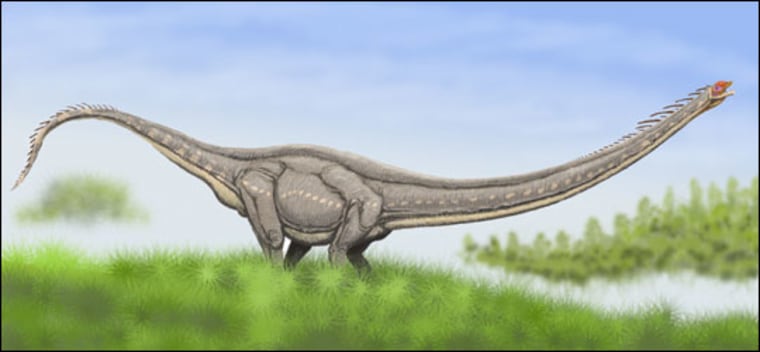Sauropod dinosaurs — the group including the well-known Apatosaurus (formerly known as Brontosaurus) — could not have kept their long necks in a vertical position, according to a new study.
At best, the dinosaurs would have needed to expend nearly half their energy just to hold their necks up, the study found. At worst, they would have passed out after lifting their heads at a 90-degree angle.
The study, published in the latest Royal Society Biology Letters, adds to an emerging consensus that sauropods held their necks — up to 30 feet long — in a horizontal position. In the future, museum exhibits, movies and books may reflect the change in their depictions of these enormous prehistoric animals.
Based on the new findings, it is believed that sauropods held their heads more like a horse than a giraffe.
"Blood pressure at a minimum can be calculated exactly from the vertical distance above the heart," he explained.
In Mamenchisaurus, for example, skeletal remains show its head, if the animal had reared, would've been more than 11 meters, or 36 feet, above its heart.
To generate high enough blood pressure to keep its head held high, the dinosaur's heart would have needed to have been five times thicker and 15 times heavier than that of an animal with more average blood pressure, according to the study.
Modern giraffes face similar challenges, but their necks are "only" about 6.5 feet long. Nevertheless, a giraffe's blood pressure "is about twice that of normal mammals," Seymour said. "If they had 9-meter (29.5-foot) necks, giraffes would be in the same problem as high-browsing sauropods."
Seymour's calculations didn't stop there.
He determined that the cardiac work rate of a sauropod holding its neck vertically would have been 7.5 times higher than that of many modern animals.
This, in turn, would have required a high metabolic rate, with sauropods expending 49 percent of their total energy requirements "just to circulate the blood."
Such a supercharged, yet wasteful, cardiovascular system never evolved in sauropods, argues Seymour.
"They would have fainted, as you would in less than five seconds without blood flow to the brain," he said.
So why did sauropods have such long necks?
Octavio Mateus, a paleontologist at the Universidade Nova da Lisboa, believes the reason was sexual selection — sauropods may have found the trait attractive in potential mates, and longer necks evolved as a result
Seymour believes long necks served a number of functions.
"Like a vacuum cleaner, a long neck would have allowed feeding to perhaps 19.6 feet in height without moving the bulk of the body," he said, adding that sauropods could have also used their necks to reach aquatic vegetation from land, or even to feed on the bottom of sea floors "while the body floated."
